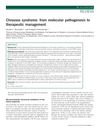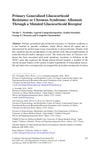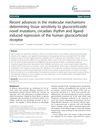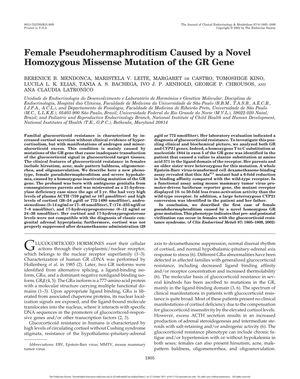TLDR A new gene mutation causes female pseudohermaphroditism due to glucocorticoid resistance.
The study described a novel case of female pseudohermaphroditism caused by a homozygous missense mutation in the GR gene, leading to glucocorticoid resistance. The patient, born with ambiguous genitalia, exhibited severe hypokalemia and high levels of ACTH, cortisol, androstenedione, testosterone, and 17-hydroxyprogesterone, which were inconsistent with classic congenital adrenal hyperplasia. Genetic analysis revealed a T to C substitution at nucleotide 1844 in exon 5 of the GR gene, resulting in a valine to alanine substitution at amino acid 571, significantly reducing receptor binding affinity and trans-activation activity. This case highlighted that pre- and postnatal virilization can occur in females with glucocorticoid resistance syndrome.
65 citations
,
December 1986 in “The Journal of Clinical Endocrinology & Metabolism” The woman had a genetic condition causing high cortisol and androgen levels, treatable with dexamethasone.
 47 citations
,
February 2015 in “European Journal of Clinical Investigation”
47 citations
,
February 2015 in “European Journal of Clinical Investigation” The review suggests thorough evaluation and genetic testing for proper diagnosis and treatment of Chrousos syndrome.
 December 2016 in “Springer eBooks”
December 2016 in “Springer eBooks” Chrousos Syndrome is caused by mutations that make the body less sensitive to glucocorticoids, leading to various symptoms and requiring high-dose treatment.
 29 citations
,
May 2018 in “Clinical Endocrinology”
29 citations
,
May 2018 in “Clinical Endocrinology” Recent genetic insights show that low-renin hypertension includes a range from essential hypertension to secondary or familial forms, affecting diagnosis and treatment.
 62 citations
,
August 2014 in “BMC Endocrine Disorders”
62 citations
,
August 2014 in “BMC Endocrine Disorders” New findings explain how genetic changes, body clocks, and certain molecules affect tissue response to stress hormones.
 November 2016 in “Elsevier eBooks”
November 2016 in “Elsevier eBooks” Genetic mutations can affect female sexual development, requiring personalized medical care.





